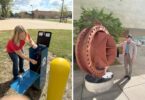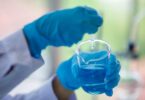Exclusive: H2O Global News’ Natasha Posnett spoke with Oissan Engineering’s Kyle Hopkins about their new offshore desalination technology – Waterfountain. They discussed all of its environmental benefits, but also the importance of education and awareness when introducing new solutions into an industry.
In a world where we are struggling to meet our freshwater demands, and with the global water crisis becoming ever more present, it is essential that we utilise all the technologies available to produce freshwater. However, further issues arise when these technologies create their own detrimental consequences to the planet. There is no point in solving one problem just by exacerbating another one. Desalination is one technique used to create freshwater, but conventional methods come with downsides to the environment. This is not news to most people, yet it is still being favoured as a solution to overcome global water stresses. Oissan Engineering has rethought the conventional method and come up with a new desalination technology which reduces environmental issues and puts sustainability at its core.

Introducing Waterfountain Waterfountain is an innovative offshore desalination system that works with nature to reduce the cost and environmental impact of desalination. This technology could help meet the global need for water while simultaneously addressing sustainability.
Oissan Engineering Chief Administrative Officer, Kyle Hopkins said: “At Oissan Engineering we believe everyone deserves access to clean water and that providing it should not harm the environment. So, we created Waterfountain with two main principles in mind; provide water and protect the planet.”
Waterfountain is unique in a number of important ways. The system requires no chemicals, is ideally powered by renewable energy and reduces brine salinity by up to 95%. Waterfountain can also reduce operating cost by up to 50%, decrease the amount of land required by 90% and can be relocated and easily removed. All of this is achieved without the need of moving parts or pumps which can require a lot of maintenance. Furthermore, this technology is very scalable while still being close to the point of need. All of these factors address the importance of sustainability. There are three models of Waterfountain, Waterfountain 10 is an unmanned spar buoy and produces 2,000 m³ per day, Waterfountain + is vessel based and produces 40,000 m3 per day, Waterfountain Max is an offshore platform and produces over 100,000 m³ per day. Waterfountain 10 is currently in production.

Environmental or water sustainability: it doesn’t have to be one or the other
We shouldn’t have to choose between addressing the water crisis or committing to environmentally friendly practices. They need to be looked at together as a combined issue. Conventional desalination comes with its benefits and is helping many communities around the world reach their freshwater needs, but the negative impacts should not be ignored or overlooked.
Hopkins spoke about some of the areas that Waterfountain has improved on when compared to conventional desalination: “Desalination is a potential solution for providing fresh water, but it comes highly flawed. There is more and more research coming out about the harmful effects of brine and, currently, standard desalination creates 56,800 Olympic sized swimming pools of brine per day! On top of that, 12,000 tons of membranes are thrown away every year and approximately 11% of operating expenses are spent on pre-treatment with chemicals. On the other hand, Waterfountain doesn’t require any pre-treatment, it uses a passive filter and does not create brine. The membranes should last 2-3 times longer with the ultra-low flow, low biofouling system, creating less waste. Waterfountain can also be powered by wind energy. We address all of these challenges presented by desalination.”
Waterfountain tackles some of the biggest sustainability issues of today; working towards a circular economy, using renewable energy, reducing waste and removing the need for prime land development.
A circular economy is one that focuses on eliminating waste and pollution, while keeping products and resources in use. It is a current focal point for industries as the world moves towards a more environmentally friendly future and Waterfountain fits the model well. Perhaps the biggest change from conventional desalination is the use of wind energy, a renewable energy source, to power the desalination process. Removing or reducing fossil fuel derived energy from the equation reduces the harmful production of greenhouse gasses into the atmosphere. They are also working to reduce the amount of waste sent to landfill and pollution that ends up in the oceans. Not only does this decrease the production of greenhouse gasses, but also reduces operational costs and helps to maintain a healthy ocean ecosystem. Land development is always a controversial topic, especially when it is near the coast. Conventional desalination requires a lot of prime, coastal land to be developed which is expensive, unsightly and one of the reasons stopping countries from using the technology more. As an offshore system, Waterfountain almost completely removes the need to build on expensive prime land. Finally, when Waterfountain reaches the end of its life it can be easily removed, leaving the natural environment in the same condition as it was previously.
It is not simple to meet all the demands of a sustainable, circular economy, but Waterfountain is a technology which adopts many components.
What’s next?
It is still early days for Waterfountain, but they are moving forwards quickly, and units will be available to be put into action around the world soon.
Hopkins explained: “Over the coming year I am hoping to get people realising that Waterfountain is viable; that it really works, it’s profitable and better for the environment. Whether that’s an independent user, such as a hotel, or a small utility or industrial zone looking for water solutions, Waterfountain would benefit them all. That’s the important message. We need the decision makers to understand this technology and how it will benefit them. Our communication is a critical piece in the adoption of Waterfountain and the sustainable growth and development of our company.”
History has shown us that people are often reluctant to make the change if there is already an established technology available. Education and awareness around the added benefits that Waterfountain provides is going to be essential in the progression of this new technology.
Hopkins expanded on this point: “There is an important education component to selling Waterfountain because people aren’t very keen for change. Both the good and the bad news is that we are hearing more about the issues of conventional desalination- from the polluting greenhouse gasses, to the brine produced and unrecycled membranes. Desalination is very much a viable solution but would benefit from some further tweaks. It would further benefit from rethinking how we do it completely, and that’s where Waterfountain fits in!”
The Waterfountain desalination technology proves that desalination does not need to be environmentally damaging. It is possible to achieve both water security and environmental sustainability. With the correct education and awareness, positive changes could be implemented around the world for freshwater production.







